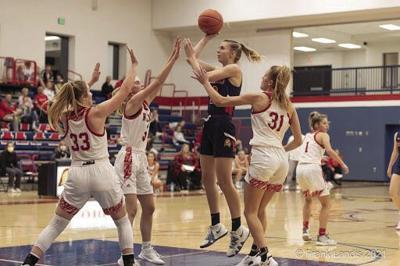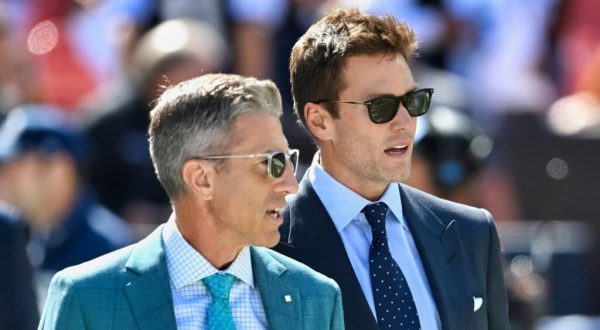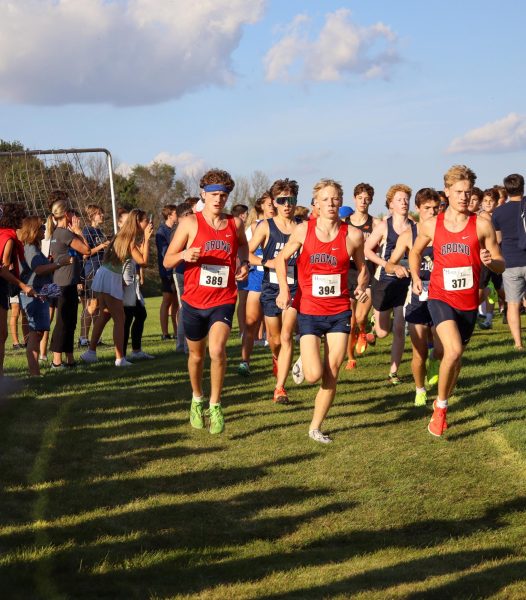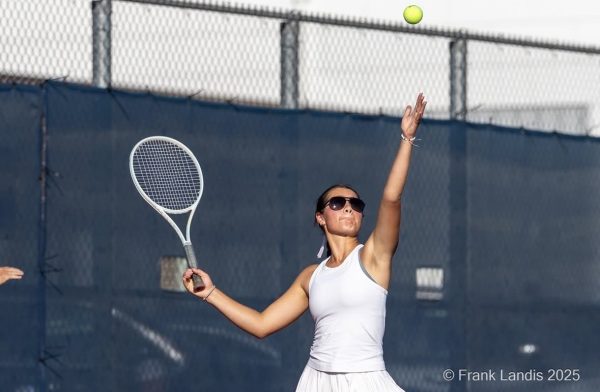Why Women’s Sports Get Less Attention – And How We Can Fix That

Kaila Youngs, former captain of the Orono girl’s basketball team, shoots in a game against Benilde.
It is a common occurrence when you go to a men’s sports game at Orono. The odds are that the stands are noticeably more crowded than when you go to a women’s game. Across nearly every sport, it seems that the boys attract more interest. But why is this?
Orono is not necessarily an anomaly regarding disparities in interest between boys’ and girls’ sports. In the latest NFHS high school athletics survey in 2021-2022, there were 98,133 girl’s participants to 111,427 boys. That 6.34% gap is actually far better than the national gap at 14.9%. Minnesota, according to USA Today, is the “poster child” for girls’ participation in high school sports, but the gap here is still a significant difference.
In the Orono basketball program, for example, the boys have around 54 players and five teams after having to cut about ten. The girls have 25 and three teams. More participation leads to a larger talent pool and in the end, more skilled play across all teams. It also leads to more friends of players coming to the games, bolstering the size of student sections with people the players know.
Boys are also, generally, friends with mostly other boys. According to a May 2022 survey, in the US only 12 percent of females would categorize themselves as avid sports fans compared to 39 percent of males. This means that more of their friends, on average, are most likely sports fans, and may be more interested in coming to their friends’ games.
“The guys can dunk. They’re in a sense more entertaining to watch because they can do more cool stuff,” Senior captain of the girls’ basketball team, Kayla Kallenbach said.
Entertaining skills lead to the more casual fan being drawn towards the boys’ games. They’re naturally more athletic. Testosterone leads to men, on average, having 10% more muscle mass than women.
“My guess would be people will say that girls’ sports aren’t as fun to watch because they’re not as athletic or whatever the case may be,” OHS teacher and avid supporter of Orono sports, Jesse Allex said.
Even in professional and collegiate leagues, people still seem to use the reasoning that they’d rather watch the highest form of the sport, the one with the most athleticism. Usually, they find that to be on the men’s side.
“I guess a lot of men and boys say that they can go out and beat the girls’ team easily, right? So, they think they can already do it. It doesn’t excite them to go watch it,” varsity women’s basketball coach Chris Bjoorgard said.
Males tend to believe that they are naturally better or more athletic than girls, and so are not as impressed by girls’ teams. Boys, on the other hand, with their frequent displays of athleticism, seem more exciting. Girls’ sports, because they cannot rely on the more physical aspects of the game, have to pay attention to the smaller details.
“Girls have to execute a little bit more, I think, and so it’s more of a pure basketball game,” Bjoorgard said.
That requires fans to be more interested in the details of the game rather than the adrenaline filled moments the boys’ games often produce. Instead of marveling at a high-flying dunk in a boy’s game, observers may have to appreciate the decision making and footwork of the girls. The casual fan probably would be more drawn towards the obviously incredible plays instead of the subtle ones offered by the girls.
In addition to many people seeing the boys as more exciting, the schedule presents a problem as well.
“We play the same nights a lot,” Barry Wohler, the boys varsity basketball coach said, “The students that cheer for each other is playing sports.”
For example, the boys and girls for certain sports, such as basketball, usually play the same nights. While one team might play a certain school at home, the other team will play the same school away.
“I grew up in a small town and the boys and the girls played on the same night [at home]. So, we had a huge crowd for both boys and girls,” former athlete and Orono gym teacher Kristen Hintz said.
The people most interested in sports are usually unable to go to one another’s games because of scheduling conflicts. With Mondays and Wednesdays mostly off limits, there are only about three days that schools like Orono have to work with to schedule all of their sports. In the winter season, that means boys and girls hockey, basketball, dance and wrestling all have to be squeezed into Tuesdays, Thursdays and Fridays. Inevitably, there will be some overlap.
So, the problem may be the casual fans. The ones who go to games for the social and student section experience instead of to watch the actual game. These people are much more likely to go to games on Fridays when they do not have school the next day.
When comparing the boys’ and girls’ varsity basketball schedules, there is a stark difference in these types of games. While the girls have nine total Friday games this year, only four homes, the boys have 12 total Friday games, with eight at home. That is twice as many home Friday night games for the boys than the girls. These are the types of games that are most accessible to the student body, and the boys have the advantage in that category as well.
Some people may try to argue that the boys might simply be the better team, rankings-wise, and that is why there is more interest in them.
Even when the girls’ team is better rankings-wise than the boys’ team, the number of fans for the boys’ games is much higher.
“The [boys] still get way more [fans],” Senior captain of the girls’ basketball team, Lauren Knudson said.
The disparity in interest is not confined to basketball either.
“We went to state almost every single year. And the guys still have all the students,” Kallenbach, also a member of the girls’ varsity soccer team, said.
This goes back to the stereotypes portraying women and girls as less athletic and not as fun to watch. Even when the girls are competitive, most fans will be drawn to the boys’ games.
“The girls are really good right now and they don’t seem to get nearly as many fans… But the boys will get a huge section whether they’re good or not,” Allex said.
What does all this mean? Well, for one, society has to recognize that it is a problem. It cannot be simply accepted as normal to have the girls garnering markedly less attention. And once it is recognized, then society can go about solving it.
In youth associations, girls and boys should be equally encouraged to play sports. Not only does this help increase the talent pool and make girls teams more skilled, but according to Missouri University Health, athletes also generally do better in the classroom, are taught teamwork and problem-solving skills and have, on average, higher self-esteem.
Stereotypes portraying females as less athletic, not as fun to watch, etc. should be combatted. Boys make up a larger percent of the sports fan category, and so are crucial to increase interest in girls’ sports. Without boys being interested, you’ve already lost over half of your target audience.
The schedule should be created more fairly and equally. The girls should not be stuck getting the short end of the stick when it comes to Friday home games, which are the most likely to attract fan sections. Boys and girls should both have equal chances to showcase their abilities in front of their peers.
Big home games should be announced to the student body. Students should know when sports games are so that they are more likely to go and support Orono athletes of both genders. Through social media and the morning announcements, this is an easy, quick fix. Football has announced their games over the loudspeaker; why can’t the other sports?
The discrepancy in interest between boys’ and girls’ sports at Orono is problematic, but think about this: if these are problems within the best state for girls’ sports in the country, what is it like for female athletes in other states?
However, there is reason to hope. Because of reforms such as Title IX, since the NFHS began surveying athletic participation in the US in 1971-1972, the gap between boys and girls has gotten significantly smaller. Then, there were 3.6 million boys to around 300,000 girls nationwide playing high school sports. Now, there are 4.3 million boys to 3.2 million girls.
Plus, interest has risen. Professional women’s sports leagues have been created in the past decades and have slowly gained popularity. Collegiate women’s sports have garnered more attention as well. For example, the past NCAA women’s basketball championship game was, according to ESPN, the “most watched season finale in nearly two decades”, reaching 4.85 million viewers on ESPN Networks.
Signs like these indicate growth, but that growth did not happen on its own. Without the students at Orono paying attention to this issue and taking accountability to try to solve it, it will not get better. Change is not magical; it is driven by people. And the Orono community should start asking what they can do to make that change.


























































Kiki • Oct 18, 2024 at 1:28 am
Thank you for this article! I’m a mom of a female athlete, and I’ve noticed the difference in the number of attendees at the girls’ matches, and was bothered by it. It seems that even fewer of the girls have parents regularly attend the girls’ matches or get involved in supporting the team. I hope you’re right that things are trending in a more balanced direction.
I’m also writing a fiction series about a female in a male-dominated sport, and found your article during a research session. It’s very insightful and thorough and gave me several good points to consider addressing in my story. Thank you again!